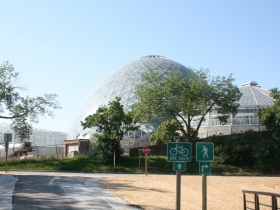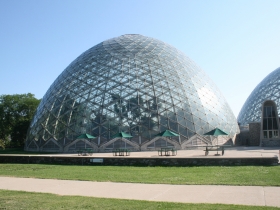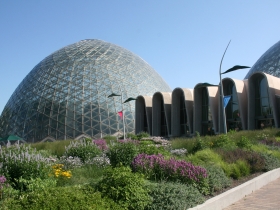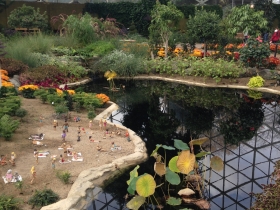Duel Over the Domes
Abele and county board creating dueling committees to address damaged domes.
Milwaukee County Executive Chris Abele and the county board are pursuing quite different plans for how to repair or replace the Mitchell Park Domes, which were temporarily closed for repairs. Urban Milwaukee has learned the Abele administration has engaged and expects to sign a contract within a week with urban design professional Larry Witzling to guide a “community engagement process” to determine what to do about the domes and which could cost as much as $30,000. Participants would include a wide range of community representatives, but no board members. And Abele has indicated he’s open to any plan, including replacing the domes.
The county board, meanwhile, will vote tomorrow on a resolution to create a nine member task force that would include at least two board members to pursue “the repair and preservation of the existing Mitchell Park Conservatory Domes.” That resolution passed in the parks committee last week. At this point, the plans appear to be proceeding on parallel tracks, with no indication either group would cooperate with the other, although the county parks director may participate in both.
The three 50-year-old domes are unique in the world, beloved by many in Milwaukee and some say part of the city’s “soul.” But they are showing their age. All were closed indefinitely February 5 after a small piece of spalled concrete was found in the Arid Dome. A quick fix this year, expected to last five to ten years, involves wrapping problematic concrete-encased steel beams with mesh. However, it will take major expenditures to keep the Domes fully functional long-term. The Abele administration has suggested the price tag could be as high as $75 million, but some board members are skeptical.
The problems go back many years. A comprehensive report by GRAEF about a decade ago recommended replacing all glass and framing. That, coupled with repairs to the filtration-and-drainage system, would reportedly alleviate problems causing concrete to flake. More recently, on July 28, 2015, a GRAEF engineering report warned the Abele administration for the second time that year: “It is imperative that the moisture issues…at the Domes be addressed if the buildings are to remain in operation and in safe condition.”
The board’s parks committee supported an allocation of $500,000 for “immediate repairs” to ensure the Show Dome can reopen in May, and the full board will vote on that tomorrow. That’s in addition to $500,000 allocated by the board in 2015 for domes repairs.
Abele’s vision for the domes was spelled out in a recent Milwaukee Journal Sentinel op-ed where he wrote: “I have proposed that we…create a long term vision for what’s next” with a “community steering group.” John Dargle, Jr., county director of parks, recreation and culture, who reports to Abele, wrote in a March 4 release that “the Parks Department is in the process of contracting with an organization which will help facilitate a series of community discussions.” He said, “All options are on the table,” including repair, restoration, rebuilding from the ground up, or a totally new facility of some kind.
Abele has said he is “open to tearing down” the Domes. He has touted replacing them with something like the serviceable “modern” domes annex or even an “amphitheater, which would cost a ton less” and be able to host performances. Abele told the Journal Sentinel’s Dan Bice “If the public says, ‘Hey, we don’t want to spend…$75 million’ I’m not going to tell them they’re wrong.”
In response to questions from Urban Milwaukee, Abele spokesperson Melissa Baldauff revealed the hiring of Witzling, calling him “a nationally recognized planning and urban design professional.” Witzling, a principal at GRAEF and former UW-Milwaukee professor, has been involved with “community engagement on large scale projects such as the World Trade Center memorial.” Baldauf said. The process “will ultimately lead to a competitive process for design and construction,” she added, noting that the Abele administration “is preparing a not-to-exceed cost of $30k for this first phase of steering committee and public information meetings” and anticipates “finalizing this contract in the next week…The funding is available in the capital project budget for the domes as approved by the Board and County Executive.”
Dargle told the county board parks committee the initial phase of “public engagement and research” would take three to six months. He outlined the makeup of the administration’s proposed “Conservatory Task Force” at the county’s parks committee March 8. Participants would include: the horticultural services manager for the Domes (Sandy Folaron), Friends of the Domes president, representatives of the Milwaukee Brewers Foundation, Clarke Square Neighborhood Initiative, Journey House, Milwaukee Public Schools’ Department of Business, Community and Family Partnerships, NEWaukee, Potawatomi Bingo and Casino and Visit Milwaukee. Others members would be a horticultural practitioner, a member of a historical preservation group, a Milwaukee County resident and a consultant.
The plan, it seems, is for this group to decide on what should be done about the domes. “When it comes to a long-term plan for the Domes the County will go through a nationwide RFP process,” Baldauf noted, hiring someone to design and executive whatever plan (repair, replacement, you name it) is decided on.
Meanwhile, Sups. Gerry Broderick, Jason Haas, Theodore Lipscomb, Sr. and Steve Taylor introduced a substitute resolution that includes a task force to pursue “the repair and preservation of the existing Mitchell Park Conservatory Domes.” Supervisors acknowledged the importance of the domes to county residents, Haas said. “We got the message. People want the domes.” Short-term repairs will buy time but won’t solve chronic problems. Dargle told the board members he did not want “the administration’s hands tied” by a committee committed only to “repair or preservation,” though Broderick said the group “would consider all options.”
The board-led task force would have nine members or designees. It would include the county’s parks director (Dargle); the District 12 county supervisor (where the Domes are located); chair of the parks, energy, and environment committee; chair of the Milwaukee County Parks Advisory Commission; a Friends of the Domes representative; “two members of local community organizations representative of the diversity of Milwaukee County” and one additional member appointed by the county board chair as the task force’s chair. Meetings would be staffed by the comptroller’s office. The task force would report back to the parks committee no later than September 2016.
The board’s resolution passed 6-0 in committee. There are reportedly sufficient votes for board approval.
It appears that Abele’s proposed committee will not be reviewed or approved by the full board, and will proceed parallel to the board task force. When asked about the seemingly duplicative efforts, Sup. Broderick, chair of the parks committee, said, “I suppose [Abele] could sign a contract without board approval” but added, “it would be folly.” Broderick said he hoped a long-term contract for such planning would not be signed “weeks before an election.”
The county board hosted a full-house hearing about the domes’ future February 24 attended by several hundred people. About 50 citizens expressed nearly universal support for preserving the iconic horticultural oasis. Abele did not attend that hearing but said during last week’s televised debate that “we still need to hear from the public” about whether residents favor spending money to keep the domes in full flower.
In his op-ed, Abele talked about preserving the Domes only in reference to possible high costs and that “the materials and technology used…are now outdated.” He told Bice that the Domes’ glass “is not even made anymore.”
That wire-embedded glass is indeed outdated. However, the operations director of the company that supplied all the original glass and framing for the domes told Urban Milwaukee “there are multiple options for replacing the glass with better choices while retaining the same look.” Richard Poklar of SuperSky Products Enterprises, LLC of Mequon said the technology has since improved that could eliminate issues of leaking. He said SuperSky has not been involved in serving the domes’ glass for at least a decade. The company serves “monumental” buildings around the world, he said, including the Calatrava-designed addition to the Milwaukee Art Museum.
Although long-term preservation seems doable, if costly, Abele’s senior officials have repeatedly said the domes are “at the end of their useful life.” GRAEF representatives, however, have said the domes are “structurally sound” and that concrete flaking affects only the surface.
The Domes’ plight has also garnered national attention and support. The Cultural Landscape Foundation (TCLF) has named the domes an “at-risk cultural landscape” and has committed to bringing attention to their architectural status and value to the community. The TCLF analysis compares the domes’ significance to Milwaukee to that of the St. Louis Gateway Arch, calling them both “Modernist marvels.”
Meanwhile, citizens favoring the domes have launched social-media sites, actions and fundraisers.
Adrienne Pierluissi, owner of the Sugar Maple bar in Bay View, is hosting a benefit in April to help save the Domes, one of her favorite places. She told WISN-TV “I just felt like I can’t sit around and do nothing.”
The Domes
More about the Future of The Domes
- Milwaukee County Board Reaffirms Commitment to Redevelopment and Restoration of Mitchell Park Domes - County Board Chairwoman Marcelia Nicholson - Sep 18th, 2025
- MKE County: Committee Cautiously Approves Domes Development - Graham Kilmer - Sep 3rd, 2025
- MKE County: Crowley Approves $30 Million for Domes - Graham Kilmer - Jul 30th, 2025
- County Executive Crowley, Chairwoman Nicholson Sign Legislation Approving Plan to Redevelop and Restore Mitchell Park Domes - David Crowley - Jul 30th, 2025
- MKE County: Board Approves $30 Million Commitment For Domes - Graham Kilmer - Jul 24th, 2025
- Why Mitchell Park Needs The Domes - Graham Kilmer - Jul 22nd, 2025
- MKE County: Parks Committee Backs $30 Million Domes Deal - Graham Kilmer - Jul 8th, 2025
- MKE County: Domes Plan Requires $30 Million From County - Graham Kilmer - Jul 2nd, 2025
- MKE County: Domes Project Lining Up Key Financing Component - Graham Kilmer - Feb 28th, 2025
- MKE County: Supervisor Adds Domes Project to 2025 Budget - Graham Kilmer - Oct 24th, 2024
Read more about Future of The Domes here



























Could any of this damage been caused from the Falk explosion in 2006 that cracked some of the glass?
I’d much rather spend my tax dollars on repairing this dome than building a basketball stadium.
It is not unreasonable to put tearing the Domes down on the table.
These days public projects like this need private donor support (and leadership).
Maybe they always did.
@Tony B,
I believe there was some damage to the glass following the Falk explosion, which has since been repaired. The current issues are more systemic and relating to a 50-year-old building. Here’s the link to the county’s Domes update page with links to Domes reports going back decades. One addresses the explosion.
http://county.milwaukee.gov/Domes
I was told by several experts that it would make most sense to replace all the glass and framing to create a new, secure “skin” for each Dome, rather than continuing to make piecemeal replacements of glass. They think it’s possible to use better technology while retaining the look and aura of the glass. It could be done over time and would reportedly solve many of the recurrent problems. Upgrading the filtration-drainage system would be another major piece.
I agree with Tom that preservation would likely require private donor support and leadership, not just government funding. Mary Louise Schumacher, the JS art/architecture critic, has pointed that out as well. Having current reports on restoration options and actual costs will be helpful for such discussions.
It’s shocking that Abele has the unilateral authority to waste $30,000 without Board approval.
Why on earth would Republicans in Madison give Abele the power to spend up to $99,999 without approval? It’s literally blank check!
@Tony B,
A report recently said this about the Falk incident.
• Dec. 16, 2006: Graef USA does a limited inspection of the Domes after an explosion at the Falk Corp., located a half a mile from the Domes, and finds no significant structural damage.
http://npaper-wehaa.com/shepherdexpress/2016/02/18/#?article=2705193
Long-term repair needs reflect age mostly, and specifically the need to prevent moisture intruding from cracked glass, etc. Here’s a link to various reports.
http://county.milwaukee.gov/Domes
Experts have said restoration is doable. Greaf recommended about 10 years ago replacing all glass and framing, though not the concrete-and-steel armature. Options for new glass technology would reportedly retain the look and feel of the Domes but be better in other ways. Another cause of moisture is the filtration and drainage system that needs upgrading.
Tom, yes, private donor angels would likely need to supplement governmental investments needed for preservation. And that would require leadership.
@Tony B,
An article recently said this about the Falk incident not being a factor.
• Dec. 16, 2006: Graef USA does a limited inspection of the Domes after an explosion at the Falk Corp., located a half a mile from the Domes, and finds no significant structural damage.
http://npaper-wehaa.com/shepherdexpress/2016/02/18/#?article=2705193
Long-term repair needs reflect age mostly, and specifically the need to prevent moisture intruding from cracked glass, etc.
Experts have said restoration is doable. About 10 years ago Greaf recommended about 10 years ago replacing all glass and framing in each dome, though not the concrete-and-steel armature. Options for new glass technology would reportedly retain the look and feel of the Domes but be better in other ways. Another cause of moisture is the filtration and drainage system that needs upgrading.
Link to various Domes studies: http://county.milwaukee.gov/Dom
Tom, yes, private donor support would likely need to supplement governmental investments for preservation, as is usually the case for major landmarks. And that would require leadership.